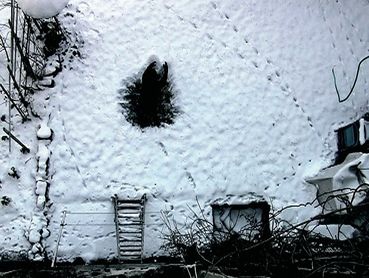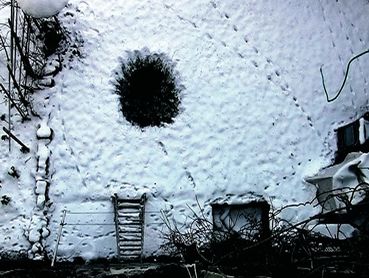MOOZ – audiovisual arts collection
Black Hole
2009, 1:50 Min., 4:3, Color, Sound
Concept and realization: Johanna Reich
Production: Academy of Media Arts Cologne
A person walks into a snow-covered garden and begins to clear the snow from a small section of the ground around them with their hands. The patch of grass in the white field of snow appears black and grows ever larger, and it gets harder and harder to make out the figure dressed in black against the dark patch of ground. At the end, the figure melts completely into the background and vanishes from our and the camera’s watchful gaze without having actually left the shot.
In 1951, Robert Rauschenberg erases a drawing by Willem de Kooning. In 1970, with his Cremation Project, John Baldessari stages the public burning of his earlier paintings. In 1975, with In Search of the Miraculous, Bas Jan Ader risks his own final disappearance. Art knows many moments of rigorous obliteration, also large often macho, and heroic gestures of disappearance.
In the videos of her series, The Presence of Absence Johanna Reich runs through the artistic, performative possibilities of her own silent disappearance. Reducing the gesture of the brush-swinging, arrogant princely painters to a profane stroke of paint, she matches interior and exterior walls to the colors of her clothes and in the process increasingly erases herself as a pictorial object and as a decisive subject from her compositions.
Black Hole (2009) is a variant of this principle, yet it is also to be read as an ironic commentary on certain practices of male fellow artists: namely, the space-filling, even mountain-moving interventions of land art. Johanna Reich’s radius of action in this less than two-minute-long video work, in contrast, extends only as far as her arms can reach. We see the artist dressed in black enter a snowy white space that is, so far, only marked with her footprints and clear the snow with her hands to such a degree that she vanishes from sight against the dark ground that has been exposed. Ground and figure appear to be one, the surface becomes a hole into which the performer sinks. The terrain over which Johanna Reich moves here is literally and figuratively muddy.
Every magic trick has clear requisites and conditions that must be met in order to succeed: here they are the white expanse of snow, the dark ground, and the corresponding clothing of the artist, as well as the special position of the camera. We observe the proceedings specifically from a view directly overhead; from any other perspective, the illusion wouldn’t work.
This overhead view is a perspective that Johanna Reich’s camera shares with drones and surveillance cameras. The views of high-resolution panoptic satellite cameras dictate our image of the Earth’s surface; they map the Earth and open it up to us visually. These performances she undertakes with a cool indifference to her subject matter are just as precise as the objectivity, obviousness, and absolute believability that we presume from this perspective.
Can we even call this apparent disappearance of the artist a trick? Or an optical illusion? Johanna Reich doesn’t surprise us with a sudden, confusing effect that overwhelms the senses; instead, she lets us observe the full, completely predictable process through the unerring eye of a camera. No stop tricks, no digital postproduction undermine the sober factuality of the video.
In the end, we see that we don’t see anything, we experience her disappearance as we simultaneously remain aware of the fact that the artist persists in her presence. A rift opens up between perception and knowledge. With the merging of the black of the artist’s clothing and the black of the ground that grows around her where she moves, we transcend the boundary between reality and its loss-generating representation, we move from visible to invisible, from the material to the imaginary.
Biology uses the term “defensive mimicry” for animals’ targeted deception of the viewer through camouflaging to match their surroundings so that they are overlooked and do not become prey: a technique of saving oneself through optically disappearing.
While visual media drive to an unprecedented degree the expansion of our field of vision, the extensive illumination, and visualization of the world, social media seeks the unqualified exposure of ourselves. How does one not become prey to this? The subtle media critique that Johanna Reich formulates with Black Hole is coupled with a proposal of seeking the dark to attempt more opacity. “The makeup of dark matter is so far unknown,” writes the artist on her work. “This form of matter emits too little visible light or other electromagnetic radiation to be directly observable.”
The other direction—from dark into light, invisibility to visibility—is pursued by the artist in her recent project Resurface (2014–2019), in which she brings life back to photographic portraits of 19th- and 20th-century women artists marginalized in art history writing. Johanna Reich reproduces 60 of these portraits as Polaroid photos, documenting the process of the image developing on video, and rescues these faces so carefully from the “black hole” of oblivion.
Text – Matthias Müller
Johanna Reich (born 1977) studied fine art at the Academy of Fine Arts Münster and the HfBK University of Fine Arts Hamburg and completed postgraduate studies in media art at the Academy of Media Arts Cologne (2007–2009), as well as exchange and artist-in-residence programs in the United States, Israel, Spain, Luxembourg, and Romania.
Johanna Reich has received such awards as the Japanese Excellence Prize for Media Arts, the Young Artist Award from the state of North-Rhine Westphalia, the Konrad von Soest Prize, and the Nam June Paik Award, among others. Her works address the progressive digitalization and increasing mediumistic appropriation of our daily lives and investigate how these influence our thinking, our understanding of our roles, and our perception.
She has shown in numerous exhibitions and her works are part of various collections, including the Goetz Collection in Munich, the Tokyo Metropolitan Museum of Photography, and the Jerry Speyer Collection in New York.










